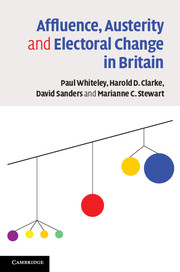Book contents
- Frontmatter
- Contents
- List of Figures
- List of Tables
- Acknowledgments
- 1 The politics of affluence and austerity
- 2 Tony's politics
- 3 Gordon's politics
- 4 ‘I agree with Nick’
- 5 Making political choices
- 6 Bearish Britain
- 7 Choosing how to choose
- 8 Performance politics and subjective well-being
- 9 Valence politics, austerity policies and electoral prospects
- Appendix A Design of the 2010 British election study
- Appendix B Measurement
- Notes
- Bibliography
- Index
7 - Choosing how to choose
The AV ballot referendum
Published online by Cambridge University Press: 05 June 2014
- Frontmatter
- Contents
- List of Figures
- List of Tables
- Acknowledgments
- 1 The politics of affluence and austerity
- 2 Tony's politics
- 3 Gordon's politics
- 4 ‘I agree with Nick’
- 5 Making political choices
- 6 Bearish Britain
- 7 Choosing how to choose
- 8 Performance politics and subjective well-being
- 9 Valence politics, austerity policies and electoral prospects
- Appendix A Design of the 2010 British election study
- Appendix B Measurement
- Notes
- Bibliography
- Index
Summary
Since the Conservative–Liberal Democrat Coalition came to power in May 2010, campaigning for change has involved more than disputes about public policy. Institutional reform has been a prominent item on the political agenda. To date, the most noteworthy effort has involved a national referendum which asked the electorate if it wished to change the time-honoured Single-Member Plurality (First-Past-The-Post) electoral system in favour of the Alternative Vote (AV) system. The AV referendum, held on 5 May 2011, was the first national referendum held in the UK since 1975 when a vote on continued membership of the European Community took place. The AV referendum arose out of the agreement reached between the Conservatives and Liberal Democrats when they formed a coalition after the 2010 general election. Negotiations on this issue were difficult because the Conservatives had opposed changing the electoral system in their party manifesto where they had promised to keep the single-member plurality (first-past-the-post) system. In contrast, the Liberal Democrats had called for the Single Transferable Vote (STV) electoral system in their manifesto.
The agreement that the two parties reached on holding a referendum on AV was an important element of the larger deal they made on the terms for forming a coalition government. Fundamentally, the Conservatives got what they wanted with regard to the economy and public-sector finances, namely Liberal Democrat support for a vigorous austerity programme. In return, the Liberal Democrats received support for holding a referendum on changing the electoral system. Although Liberal Democrat Leader, Nick Clegg, had labelled AV a ‘miserable little compromise’ before the 2010 election, he and his colleagues knew that it was a compromise that held promise of enabling them to do both ‘good’ and ‘well’. The Liberal Democrats would do ‘good’ because democratically motivated institutional reform was a longstanding goal for the party which prided itself on advocacy of a progressive political agenda. Implementing AV would mean that elections very likely would produce a closer match between a party's popular vote total and its share of parliamentary seats, thus providing more equitable representation at Westminster.
- Type
- Chapter
- Information
- Affluence, Austerity and Electoral Change in Britain , pp. 196 - 229Publisher: Cambridge University PressPrint publication year: 2013



